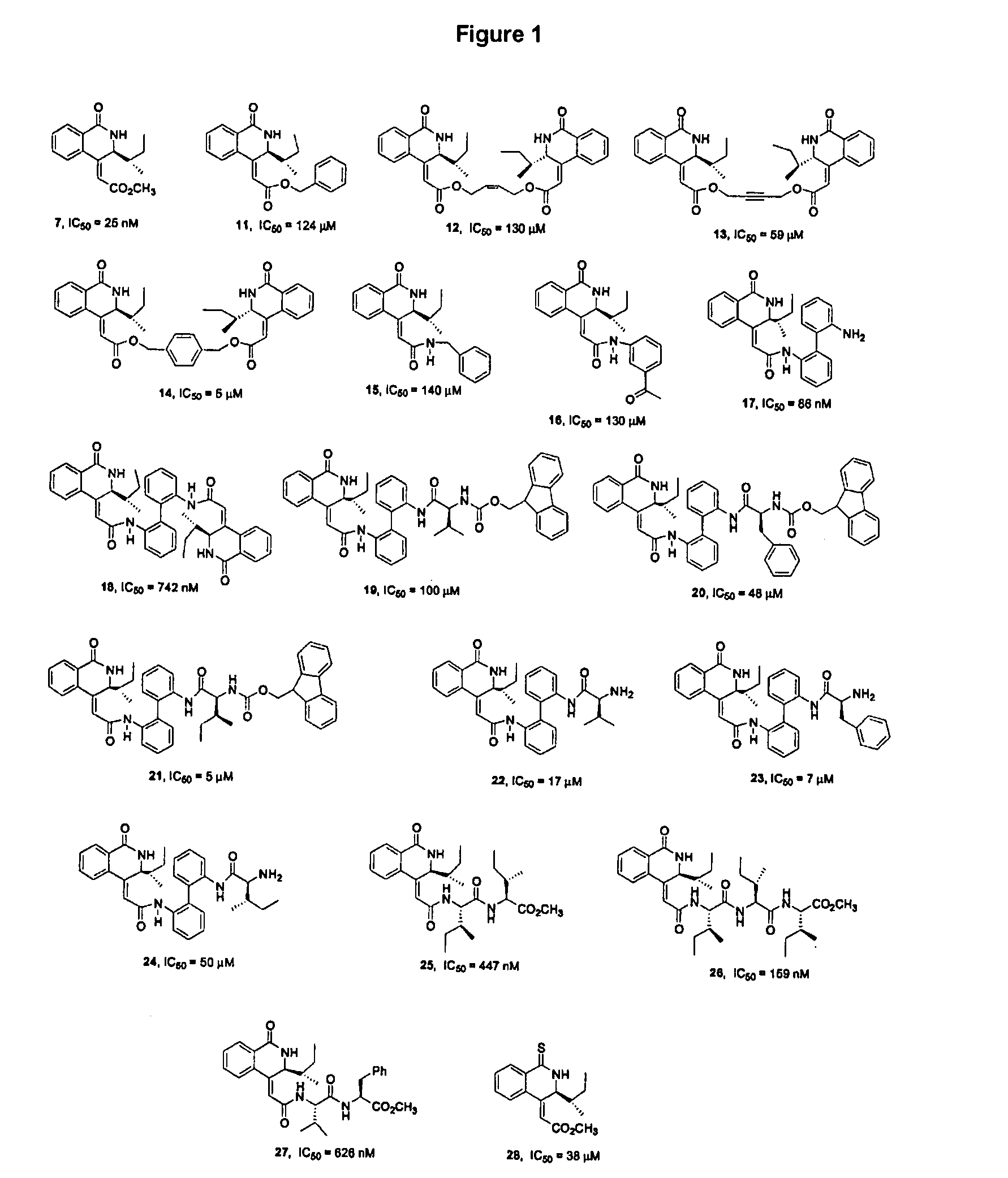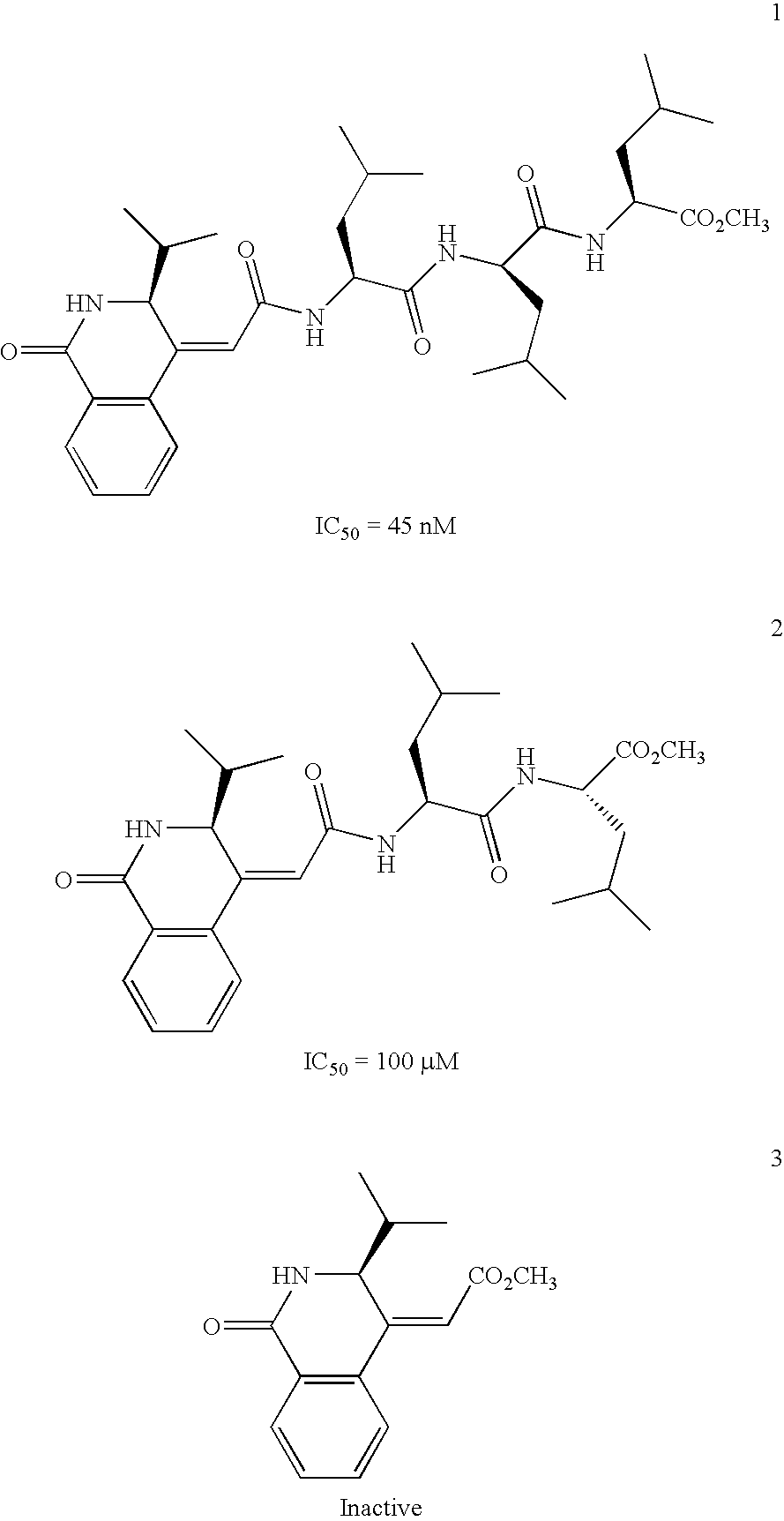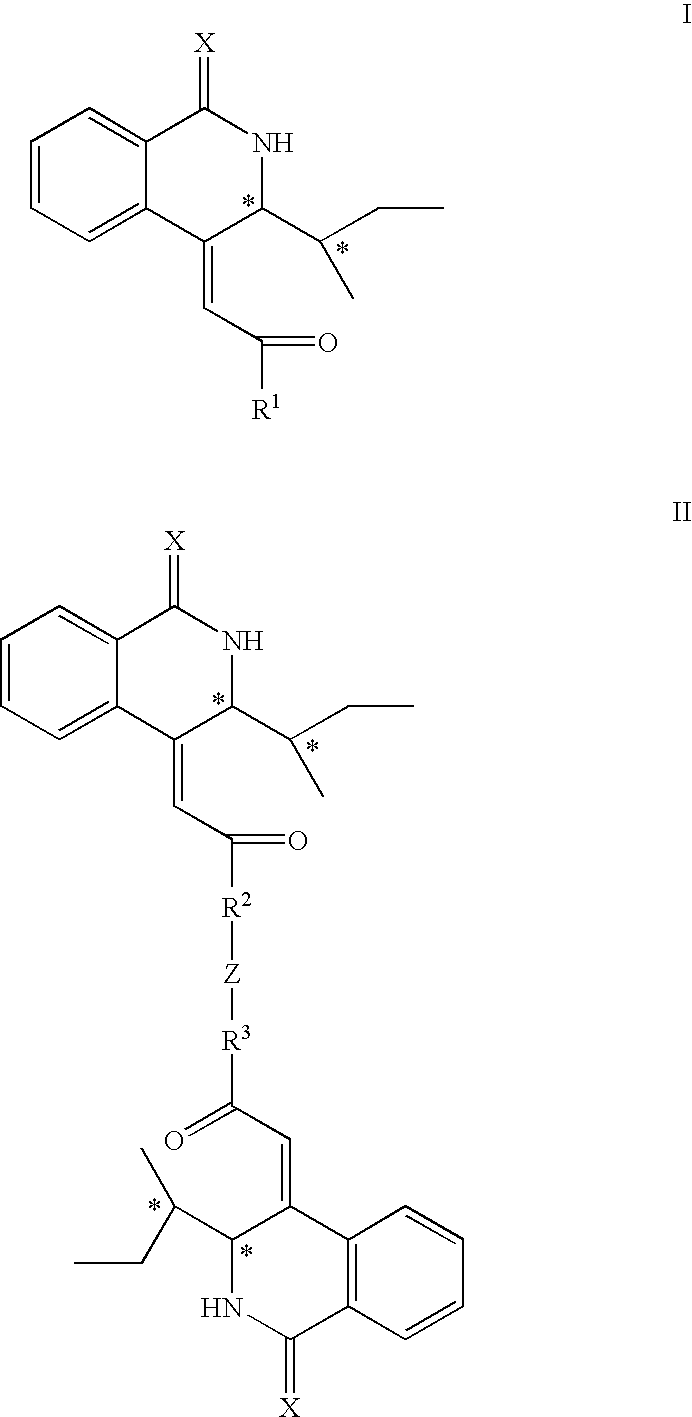Isoquinoline Derivatives as Calpain Inhibitors
a technology of isoquinoline and inhibitors, which is applied in the direction of application, peptide/protein ingredients, drug compositions, etc., can solve the problems of low selectivity, unsatisfactory prevention of excitotoxic action, and certain undesired pharmacological properties
- Summary
- Abstract
- Description
- Claims
- Application Information
AI Technical Summary
Benefits of technology
Problems solved by technology
Method used
Image
Examples
example 1
Synthesis of methyl (S,S)-3-methyl-2-(2-iodobenzoylamino)-pentanoate (4)
[0070]
[0071] To a solution of L-isoleucine methyl ester hydrochloride (13.07 g, 72.0 mmol) in THF (300 mL1 and H2O (300 mL), K2CO3 was added (39.80 g, 288 mmol). The mixture was cooled to 0° C. and after stirring for 5 minutes, 2-iodobenzoyl chloride (19.18 g, 72.0 mmol) was added. The mixture was stirred at 0° C. for 30 minutes and was then left to slowly reach room temperature overnight. THF was eliminated and the aqueous phase was extracted with EtOAc (3×50 mL). The organic phases were washed with brine and dried over MgSO4. Once the solvent had been eliminated in vacuo the raw product was obtained, which was purified by recrystallisation from EtOAc / hexane to give 4 (16.7 6; 62%). White solid.
[0072] m.p.: 67-70° C.
[0073] [α]D=+9.2 (c=1.0, CHCl3).
[0074] IR (KBr) v: 3436, 3294, 2964, 1743, 1644, 1585, 1525, 1463, 1201, 1015 cm−1.
[0075]1H-NMR (300 MHz, CDCl3) δ: 7.87 (m, 1H, H—C (3′)); 7.41 (m, 2H, H—C (5′)...
example 2
Synthesis of (S,S)—N-[(1-hydroxymethyl-2-methyl)-butyl]-2-iodo-benzamide (5)
[0080]
[0081] To a solution of 4 (8.44 g, 22.5 mmol) in THF (50 mL) at −10° C., LiBH4 was added (1.47 g, 67.5 mmol). Immediately afterwards MeOH (45 mL) was slowly added, the mixture was stirred at −10° C. for 10 minutes and then left to reach room temperature. After that, H2O was added, THF was eliminated in vacuo and the aqueous phase was extracted with EtOAc (3×50 mL). The organic phases were washed with brine and dried over MgSO4. Once the solvent had been eliminated in vacuo the raw product was obtained, which was purified by column chromatography using hexane / EtOAc as eluent (1:1 to 1.9) and then EtOAc, obtaining 5 (6.6 g, 85% yield). White solid.
[0082] m.p.: 125-126° C.
[0083] [α]D=−27.8 (c=1.0, CHCl3).
[0084] IR (KBr) v: 3410, 3295, 1628, 1544, 1076, cm−1.
[0085]1H-NMR (400 MHz, CDCl3, mixture of conformers M and m, 4:1) δ: 7.81 (m, 0.7 H, H—C (3′), M); 7.72 (m, 0.3H, H—C (3′), m); 7.50-7.31 (m, 2H,...
example 3
Synthesis of methyl (S,S,E)-5-methyl 4-(2-iodobenzoylamino)-2-heptenoate (6)
[0090]
To a commercial solution of 2M oxalyl chloride in anhydrous CH2Cl2 (10.33 mL, 20.8 mmol) diluted with the same solvent (12 mL) at −78° C. was added dropwise a solution of anhydrous DMSO (2.9 mL, 41.0 mmol) in anhydrous CH2Cl2 (30 mL). The mixture was stirred for 30 minutes at −78° C. after which a solution of the alcohol 5 was added (4.44 g, 12.8 mmol) in anhydrous CH2Cl2 (25 mL) dropwise by means of a cannula. The mixture was stirred for 1 hour at −78° C. and Et3N was then added (10.26 ml, 74.0 mmol) dropwise. After stirring for approximately 1 hour at −78° C., when the oxidation of the aldehyde was complete (tic), Ph3P═CHCO2Me was added (6.0 g, 19.0 mmol) and the reaction was then left to slowly reach room temperature overnight. Finally, the solvent was eliminated in vacuo obtaining a raw product, which was purified by column chromatography using hexane / EtOAc as eluent (4:1 to 1.1) providing the E ...
PUM
 Login to View More
Login to View More Abstract
Description
Claims
Application Information
 Login to View More
Login to View More - R&D
- Intellectual Property
- Life Sciences
- Materials
- Tech Scout
- Unparalleled Data Quality
- Higher Quality Content
- 60% Fewer Hallucinations
Browse by: Latest US Patents, China's latest patents, Technical Efficacy Thesaurus, Application Domain, Technology Topic, Popular Technical Reports.
© 2025 PatSnap. All rights reserved.Legal|Privacy policy|Modern Slavery Act Transparency Statement|Sitemap|About US| Contact US: help@patsnap.com



